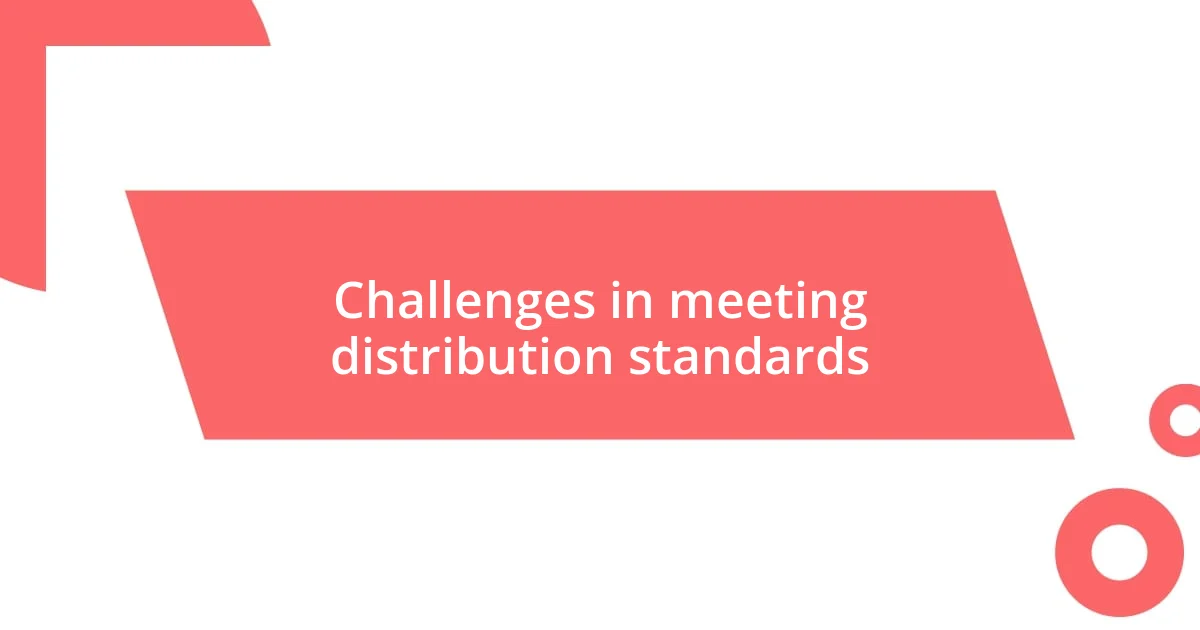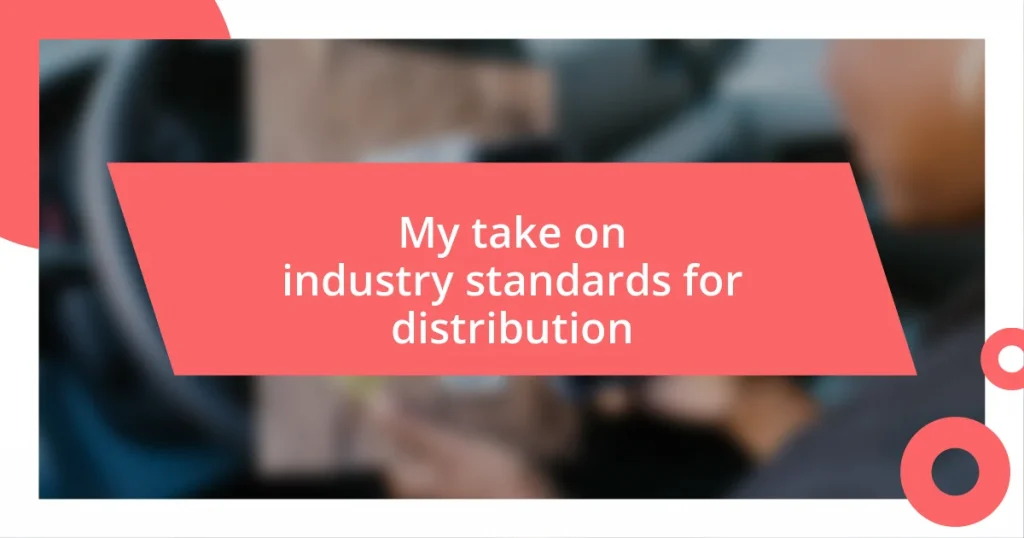Key takeaways:
- Understanding and adhering to distribution industry standards enhances operational efficiency and corporate reputation.
- Key components of distribution efficiency include timely communication, effective inventory management, and automated processes.
- Future trends in distribution emphasize sustainability, hyperlocal delivery models, and the use of predictive analytics for proactive inventory management.

Understanding distribution industry standards
Understanding distribution industry standards is crucial for any professional in the field. You might wonder, why do these standards matter? In my early days working in logistics, I saw firsthand how adherence to established protocols can make or break a company’s efficiency and reputation.
These standards provide a framework that helps businesses ensure consistency and quality in their operations. I remember participating in a compliance audit that revealed gaps in our processes—gaps that, if left unchecked, could have led to major headaches down the line. It made me appreciate how important it is to have a clear set of guidelines that everyone can follow.
When you think about distribution standards, consider them as the backbone of the industry. They’re not just regulations; they’re the foundation upon which successful distribution strategies are built. Reflecting on my experiences, I can’t help but feel that these standards empower businesses to operate effectively and respond more agilely to market demands. Isn’t it reassuring to know that there are established practices designed to guide us through the complexities of distribution?

Key components of distribution efficiency
When discussing distribution efficiency, several key components stand out. First, timely communication is essential. In my career, I’ve experienced scenarios where a simple delay in sharing information caused a ripple effect, slowing down the entire supply chain. I learned just how critical it is to keep all stakeholders informed to ensure smooth operations.
Next, inventory management plays a significant role in efficiency. I remember a time when a lack of proper inventory tracking led to stockouts and excess surplus, disrupting our workflow. Implementing real-time tracking systems helped drastically reduce those frustrations, allowing us to be more responsive to customer demands.
Lastly, automated processes can enhance efficiency dramatically. I recall implementing a warehouse management system that streamlined our picking and packing operations. The transformation was eye-opening—not only did our output improve, but the morale of the team also skyrocketed as they spent less time on mundane tasks.
| Component | Description |
|---|---|
| Timely Communication | Ensures all stakeholders are aligned, preventing delays. |
| Inventory Management | Utilizes tracking systems to maintain optimal stock levels. |
| Automated Processes | Streamlines operations, boosting efficiency and team morale. |

Best practices for effective distribution
Effective distribution is more than just a series of tasks; it’s about cultivating a mindset that cherishes precision and reliability. In my experience, one standout practice is fostering a culture of accountability. I can vividly remember a time when an error in order fulfillment sparked a cascade of disappointed customers. It was a wake-up call, reminding me that every team member has a role in ensuring accuracy. Encouraging ownership over one’s work not only enhances performance but instills a sense of pride in delivering quality.
Here are some best practices that I’ve found vital for effective distribution:
- Clear Roles and Responsibilities: This prevents overlaps and miscommunication, allowing everyone to focus on their specific tasks.
- Regular Training: Staying updated with the latest technologies and processes keeps the team efficient and ready for challenges.
- Feedback Loops: Establishing channels for constructive feedback helps identify areas for improvement and reinforces team morale.
- Performance Metrics: Utilizing data to gauge performance creates transparency and encourages continuous enhancement.
- Collaborative Problem Solving: I’ve seen how bringing diverse perspectives together can spark innovative solutions to distribution challenges.
These practices not only streamline operations but also nurture a supportive environment where everyone feels valued and engaged. It’s about building a community within the workplace, where each contribution is recognized, and continuous improvement is a shared goal.

Technology’s role in distribution standards
Technology plays a pivotal role in shaping distribution standards. I vividly recall implementing a new software solution that revolutionized our order processing. It was incredible to see how quickly data could be shared, reducing the chances of errors and enhancing overall efficiency. Have you ever had one of those moments where everything just clicks? That’s what technology can do—it streamlines workflows, minimizes misunderstandings, and keeps the entire team on the same page.
Moreover, advancements in tracking technologies, like RFID and GPS, truly transform inventory management. When I first encountered these systems, I was amazed at their accuracy. Suddenly, we could pinpoint the location of our stock in real-time. I remember a colleague exclaiming, “It feels like we can see into the future of our inventory!” That kind of visibility not only enhances decision-making but also enables proactive rather than reactive strategies in distribution practices.
Of course, technology doesn’t work in a vacuum; it thrives when there’s a culture that embraces change. During an overhaul at one of my previous companies, I encountered skepticism among team members about adopting a new platform. It reminded me how crucial it is to engage everyone in the process. By involving them in discussions and highlighting the benefits, we shifted the narrative. Together, we transformed from a hesitant team into tech-savvy contributors, making the distribution process smoother and more efficient, which was incredibly rewarding to witness.

Challenges in meeting distribution standards
Meeting distribution standards can be a daunting task, often riddled with unforeseen challenges. One major hurdle I encountered was the variability in supplier reliability. I remember a time when a key supplier failed to deliver materials on time, throwing our entire schedule off-kilter. It was a learning moment for me; I realized the importance of contingency planning and building strong relationships with multiple suppliers to cushion against such disruptions.
Another issue that frequently arises is compliance with changing regulations. Navigating the maze of local, national, and international laws can feel overwhelming. I once found myself scrambling to update our shipping protocols after new regulations were introduced on hazardous materials. That experience taught me the significance of staying informed and proactive, reinforcing the idea that agility is vital in the distribution landscape.
Finally, let’s talk about technology adoption. I’ve seen firsthand how tech can be a double-edged sword. There’s excitement around new tools, but also apprehension, especially among team members who fear their jobs might be compromised. When I rolled out an automated system, I had some people resistant to change, worried it would replace human intuition. It took considerable effort to show them how these tools are meant to enhance efficiency—not replace them. The key takeaway for me was the necessity of communication and reassurance during transitions; it’s not just about the tech; it’s about bringing the team along for the ride.

Future trends in distribution practices
The future of distribution practices is primed for a transformation driven by sustainability. I remember when my team introduced eco-friendly packaging alternatives; the shift was met with excitement and a little skepticism. Did we really think that our customers would notice? It turned out they did—and our sales saw a boost as a result. Forward-thinking companies are realizing that eco-conscious strategies not only benefit the planet but also resonate with consumers, who increasingly prefer brands that prioritize sustainability.
As the rise of e-commerce continues, I see hyperlocal distribution models gaining traction. I felt this shift firsthand while collaborating with a local delivery startup; we could reach our customers’ doorsteps in under an hour! This personal connection and speed weren’t just advantageous for us—they made shopping more convenient for our customers. In this world of instant gratification, businesses that adopt these innovative distribution approaches will undoubtedly stand out in a crowded marketplace.
Another trend I find fascinating is the integration of predictive analytics in inventory management. I recall a time our analytics tool flagged an impending stock shortage before it happened, allowing us to adjust our orders proactively. How exhilarating it was to sidestep a potential crisis! As data drives decision-making, those who harness predictive capabilities will not only enhance efficiency but also create a more responsive distribution network. This blend of data and foresight can fundamentally reshape the way we think about inventory and customer satisfaction.















